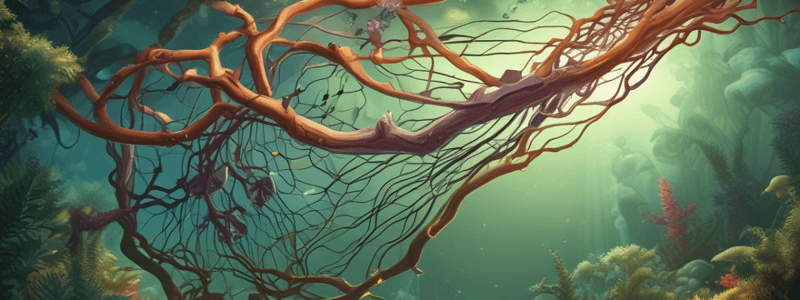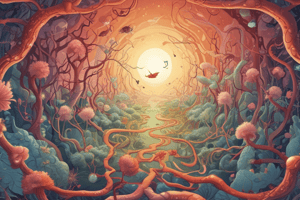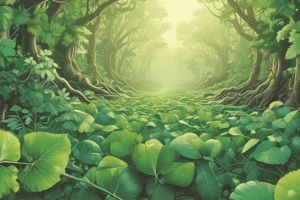Podcast
Questions and Answers
What is the scientific study of life and living organisms?
What is the scientific study of life and living organisms?
Biology
What is the study of plants?
What is the study of plants?
Botany
What is the basic structural and functional unit of life?
What is the basic structural and functional unit of life?
Cells
What is the term for the study of interactions between organisms and their environment?
What is the term for the study of interactions between organisms and their environment?
What is the term for the conversion of light energy into chemical energy?
What is the term for the conversion of light energy into chemical energy?
What is the term for the process by which cells divide to produce four non-identical daughter cells?
What is the term for the process by which cells divide to produce four non-identical daughter cells?
What are the building blocks of tissues?
What are the building blocks of tissues?
What is the term for the study of heredity and variation?
What is the term for the study of heredity and variation?
Flashcards
What is Biology?
What is Biology?
The scientific study of life and living organisms, including their structure, function, growth, evolution, distribution, and taxonomy.
What is Botany?
What is Botany?
The study of plants.
What is Zoology?
What is Zoology?
The study of animals.
What is Microbiology?
What is Microbiology?
Signup and view all the flashcards
What is Ecology?
What is Ecology?
Signup and view all the flashcards
What are molecules?
What are molecules?
Signup and view all the flashcards
What are organelles?
What are organelles?
Signup and view all the flashcards
What is Mitosis?
What is Mitosis?
Signup and view all the flashcards
Study Notes
What is Biology?
Biology is the scientific study of life and living organisms, including their structure, function, growth, evolution, distribution, and taxonomy.
Branches of Biology
- Botany: study of plants
- Zoology: study of animals
- Microbiology: study of microorganisms
- Ecology: study of interactions between organisms and their environment
- Genetics: study of heredity and variation
- Biochemistry: study of chemical processes within living organisms
Levels of Organization
- Molecules: basic building blocks of life (e.g. carbohydrates, proteins, nucleic acids)
- Organelles: specialized structures within cells (e.g. mitochondria, chloroplasts)
- Cells: basic structural and functional units of life
- Tissues: groups of similar cells performing specific functions
- Organs: structures composed of multiple tissues
- Organ Systems: groups of organs working together to perform specific functions
- Organisms: individual living beings
- Populations: groups of organisms of the same species
- Communities: groups of different species interacting with each other
- Ecosystems: interactions between living and non-living components of an environment
- Biosphere: all living components of the Earth
Biological Molecules
- Carbohydrates: energy source for cells (e.g. glucose, starch)
- Proteins: building blocks of tissues (e.g. enzymes, collagen)
- Lipids: energy storage and structural components (e.g. fats, cholesterol)
- Nucleic Acids: genetic material (e.g. DNA, RNA)
Cellular Processes
- Photosynthesis: conversion of light energy into chemical energy
- Cellular Respiration: conversion of chemical energy into ATP
- Mitosis: cell division resulting in two identical daughter cells
- Meiosis: cell division resulting in four non-identical daughter cells
What is Biology?
- Biology is the scientific study of life and living organisms, including their structure, function, growth, evolution, distribution, and taxonomy.
Branches of Biology
- Botany is the study of plants.
- Zoology is the study of animals.
- Microbiology is the study of microorganisms.
- Ecology is the study of interactions between organisms and their environment.
- Genetics is the study of heredity and variation.
- Biochemistry is the study of chemical processes within living organisms.
Levels of Organization
- Molecules are the basic building blocks of life, including carbohydrates, proteins, and nucleic acids.
- Organelles are specialized structures within cells, such as mitochondria and chloroplasts.
- Cells are the basic structural and functional units of life.
- Tissues are groups of similar cells performing specific functions.
- Organs are structures composed of multiple tissues.
- Organ Systems are groups of organs working together to perform specific functions.
- Organisms are individual living beings.
- Populations are groups of organisms of the same species.
- Communities are groups of different species interacting with each other.
- Ecosystems are interactions between living and non-living components of an environment.
- The Biosphere includes all living components of the Earth.
Biological Molecules
- Carbohydrates are energy sources for cells, including glucose and starch.
- Proteins are building blocks of tissues, including enzymes and collagen.
- Lipids are energy storage and structural components, including fats and cholesterol.
- Nucleic Acids are genetic material, including DNA and RNA.
Cellular Processes
- Photosynthesis is the conversion of light energy into chemical energy.
- Cellular Respiration is the conversion of chemical energy into ATP.
- Mitosis is cell division resulting in two identical daughter cells.
- Meiosis is cell division resulting in four non-identical daughter cells.
Studying That Suits You
Use AI to generate personalized quizzes and flashcards to suit your learning preferences.




